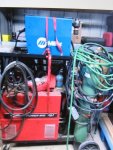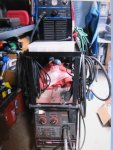From the original post, it sounds like you
- "Needing a new MIG"
- "Will need aluminum capabilities"
- "Don't know anything about TIG"
Therefore, it seems more likely that the aluminum capability desired would be MIG... and if that is the case, then the Lincoln 350MP is one of the best aluminum MIG welding wire feeders available, and is the most powerful power supply available on single phase.
The 350MP was designed from the ground up to MIG weld aluminum. If you don't know anything about tig, and want the speed of MIG when welding aluminum, then you picked the right machine.
When Lincoln introduced the 350MP, Lincoln originally called it the PM300, where PM stood for Power Mig. The 300 designation wasn't for peak welding output amperage... it was rather named for the production / manufacturing class duty cycle of 60%. 300 amps at 60% duty cycle at 32 volts was a huge leap in power output compared to the typical 250 amp rated wire feeder power supplies that the PM300 replaced and competed with. The PM300 has a very wide continuous current range of as low as 5 amps to as high as 350 amps peak output, with a welding voltage range between 10 and 45 volts. (Open Circuit Voltage is 67v).
Keep in mind, these power ratings are using single phase 230v input power. No other single phase input power machine existed that could output 350 amps, or 300 amps 60% duty cycle, or 230 amps at 100% duty cycle, spraying all day at 29 volts. On single phase.
It didn't matter than the PM300 was a multi-process machine. It didn't matter than it was constant current as well as constant voltage. It didn't matter that it was also a DC stick welder and a TIG welder. It didn't matter that it was a synergistic welder that can automatically index voltage to wire feed speed. It didn't matter that it also was a push-pull capable wire feeder, for using a push pull gun for the ultimate convenience and speed in welding aluminum. The fact remained, that even as just a plain old mig welder, or a plain old DC stick welder, there was no other power supply available on the market that could output the power and duty cycle numbers above on single phase, using a traditional transformer. Anything close or better was a 3 phase machine, at about 2 or 3 times the price.
The PM300 shook the market at the turn of the last century, and woke Miller up to scramble to produce the Miller 350P, that wasn't quite the same machine, but was close enough to motivate Lincoln to rename the PM300 to the 350MP. No difference in input or output power specifications between the two Lincoln product designations, but the 350MP included more features, like a 115V receptacle to plug in a grinder, and dual gas input solenoids. Miller's initial 350P was at one time 3 phase only, but later versions were made compatible with 1 and 3 phase input power.
So be careful in your search for reviews... as the 350MP or MP350 or PM350 or P350 are often conflated and confused by reviewers and readers who may not pay as much attention to detail. Always include the brand name in your searches, along with the correct model number. In the case of this proposed purchase, Lincoln 350MP, and in the case of wanting to compare competition, Miller 350P.
@CA_Bgrwldr mentioned Lincoln's newest/current revision of this machine, called the 360MP. The 360MP is an entirely different execution of this wire feeder welder, and is made in Mexico, not the United States. The 350MP is manufactured in Ohio... even the circuit boards to the 350MP are made in the Lincoln Electric manufacturing plant in Ohio. My understanding is that the circuit boards of the newest Lincoln machines manufactured in Mexico are sourced from China. So there is that to consider. The new 360MP is too new to get a sense of how reliable the whole 7" touch screen interface is.
The older 350MP has two big fat encoder knobs that can easily be grasped by welding gloves, even those big fat gloves that took half a cow each to make that
@MC , founder of WeldingSite.com, gave away as prizes in the membership point contribution contest held back in May 2020. Those gloves make the NASA gloves that astronauts wear for spacewalks seem small. And yet there is enough knob, and enough room between the knobs, to grapple the dial for tweaking a setting, without taking the gloves off. Something to think about with those new fancy new touch screens found on machines today.
I'm not going to talk about how the machine welds, because that more depends on how the weldor welds with it. Unless the specific used machine you are considering is broken, there are not going to be any issues with how the machine welds. And there are at least 40 wave forms in the software to choose from, on top of the synergistic and full manual control options available. How it welds isn't the question on the table here. The question "should I buy this deal" is a question that boils down to determining value.
So let's get back to talking value, circling back to available power to mig weld aluminum masses that love to wick away the heat that was introduced and intended to fuse a joint. If you've only got single phase to work with, I challenge anyone to find a single phase machine that can put out more power, at as high or as long of a duty cycle, for under $5,000. What $2,200 machine out there can produce the juice?
I hear that there are a lot of new inverter welding machines from China on the global market now, and I have no idea what they are called or what their specs are, but even if they advertise the capability of producing 300 amps of welding current... is that at 10% duty cycle? 20%? When comparing the dollar cost per welding amp, don't forget to look at that duty cycle, especially with heat sinking aluminum. And if spraying 3/8" steel plate, check what the voltage is at the rated current.
Alright already, enough about power. There are two major parts of an all in one cabinet MIG welding machine, and moving beyond the power supply, the second major part is the built in wire feeder.
The Max Trac 2 roll wire drive system in the 350MP is the same as what can be found in Lincoln's rugged LN-25 PRO suitcase wire feeder. That's a $3,000 (but supply your own DC power) suitcase that's been a commercial construction and pipeline industry standard for decades. I opened the cabinet lid to the PM300 / 350MP and took one look at that wire feeder that comes with the machine and was sold. It's like getting an LN-25 PRO feeder on top of a CC/CV 350 peak amp transformer power supply, extended by a Chopper assembly to provide inverter like performance, with Power Wave Software and wave form controls to boot, all in one machine, for less than $5,000, and it runs on single phase.
Oh, and it does Pulse MIG too? And even has Pulse on Pulse for MIG like TIG stacked dime bead appearance? Aw heck and it does TIG anyway? And SMAW too? Both soft and crisp? And Push Pull? Let's talk about push pull for a second, as it relates to that Max Trac 2 roll wire drive system.
When Miller came out with their first version of their 350P, it had a four roll wire drive system, and was advertised as a "multi process" machine with the capability to run push pull torches to keep from birdnesting soft wire like aluminum. Miller's early four roll wire drive systems didn't play very well with push pull torches. So Miller eventually made a another 350P optimized for aluminum push pull guns. with a tiny torque feed two roll wire non gear driven wire drive mechanism. After seeing how Miller saw fit to move away from their 4 roll wire drive system for dedicated aluminum push pull mig rigs, I felt like I dodged a bullet going with the 2 roll Max Trac on Lincoln's 350MP. The entire point of having a multi-process machine is to reduce the number of machines in the shop, without stepping over $10K+
It almost looks like I'm turning this into a red vs blue debate, and I don't mean to. I am just recalling some of the forks in the road where I stood 18 years ago, when I bought my Power Mig 300, which is the same machine that eventually became called the Power Mig 350MP, once Miller introduced their 350P. Since these two machines were quite a leap ahead of any similar class machine that preceded them, I ended up comparing them quite a bit, and not only found the Lincoln PM300 to be a more versatile value back then, I continue to find it to have been the right choice for me, even in retrospect, and even with Miller revamping their 350P to include the improvements it needed over the introductory version. I had to make these comparisons without benefit of any forums, because the two most populated forums online 20 years ago were owned by ITW (Miller), and thus curated an almost cult like Miller following (which appeared to help sell a lot of Miller products).
Attached photos are of the ad the OP is looking at:




